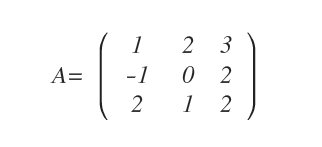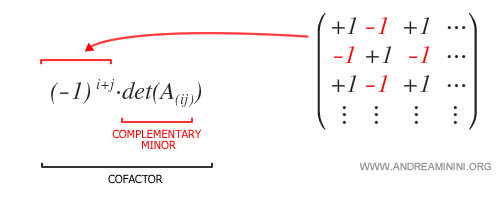Adjugate matrix
The adjugate matrix is a cornerstone concept in matrix algebra, essential for many mathematical applications. In simple terms, the adjugate (or adjoint) of a matrix is obtained by transposing its cofactor matrix. Mathematically, it’s commonly represented as "adj."

Let's walk through the process of calculating the adjugate matrix.
We’ll start with a given matrix, A:

The first step in finding the adjugate matrix is to calculate the matrix of cofactors of A.
So, what are cofactors? Cofactors, also known as algebraic complements, are derived from the minors of elements \( a_{ij} \) in matrix A, with each cofactor adjusted by (-1) raised to the power of \( i+j \).

To calculate the cofactor matrix, denoted \( \text{cof}(A) \), we use the following formula:
$$ \text{cof}(A) = \begin{pmatrix} (-1)^{1+1} \, \text{det}(A_{1,1}) & (-1)^{1+2} \, \text{det}(A_{1,2}) & (-1)^{1+3} \, \text{det}(A_{1,3}) \\ (-1)^{2+1} \, \text{det}(A_{2,1}) & (-1)^{2+2} \, \text{det}(A_{2,2}) & (-1)^{2+3} \, \text{det}(A_{2,3}) \\ (-1)^{3+1} \, \text{det}(A_{3,1}) & (-1)^{3+2} \, \text{det}(A_{3,2}) & (-1)^{3+3} \, \text{det}(A_{3,3}) \end{pmatrix} $$
$$ \text{cof}(A) = \begin{pmatrix} (-1)^{2} \cdot \text{det} \begin{pmatrix} 0 & 2 \\ 1 & 2 \end{pmatrix} & (-1)^{3} \cdot \text{det} \begin{pmatrix} -1 & 2 \\ 2 & 2 \end{pmatrix} & (-1)^{4} \cdot \text{det} \begin{pmatrix} -1 & 0 \\ 2 & 1 \end{pmatrix} \\ (-1)^{3} \cdot \text{det} \begin{pmatrix} 2 & 3 \\ 1 & 2 \end{pmatrix} & (-1)^{4} \cdot \text{det} \begin{pmatrix} 1 & 3 \\ 2 & 2 \end{pmatrix} & (-1)^{5} \cdot \text{det} \begin{pmatrix} 1 & 2 \\ 2 & 1 \end{pmatrix} \\ (-1)^{4} \cdot \text{det} \begin{pmatrix} 2 & 3 \\ 0 & 2 \end{pmatrix} & (-1)^{5} \cdot \text{det} \begin{pmatrix} 1 & 3 \\ -1 & 2 \end{pmatrix} & (-1)^{6} \cdot \text{det} \begin{pmatrix} 1 & 2 \\ -1 & 0 \end{pmatrix} \end{pmatrix} $$
Next, we simplify these calculations:
$$ \text{cof}(A) = \begin{pmatrix} (1) \cdot (-2) & (-1) \cdot (-6) & (1) \cdot (-1) \\ (-1) \cdot 1 & (1) \cdot (-4) & (-1) \cdot (-3) \\ (1) \cdot 4 & (-1) \cdot 5 & (1) \cdot 2 \end{pmatrix} $$
After evaluating the determinants and applying the appropriate signs, we find the cofactor matrix:
$$ \text{cof}(A) = \begin{pmatrix} -2 & 6 & -1 \\ -1 & -4 & 3 \\ 4 & -5 & 2 \end{pmatrix} $$
Finally, we obtain the adjugate matrix by taking the transpose of the cofactor matrix:
$$ \text{cof}(A)^T = \begin{pmatrix} -2 & -1 & 4 \\ 6 & -4 & -5 \\ -1 & 3 & 2 \end{pmatrix} = \text{adj}(A) $$
This resulting matrix is called the adjugate (or adjoint) of matrix A.
Mastering the concept and calculation of the adjugate matrix is invaluable in many mathematical processes, including solving systems of equations, finding inverses, and performing transformations.
